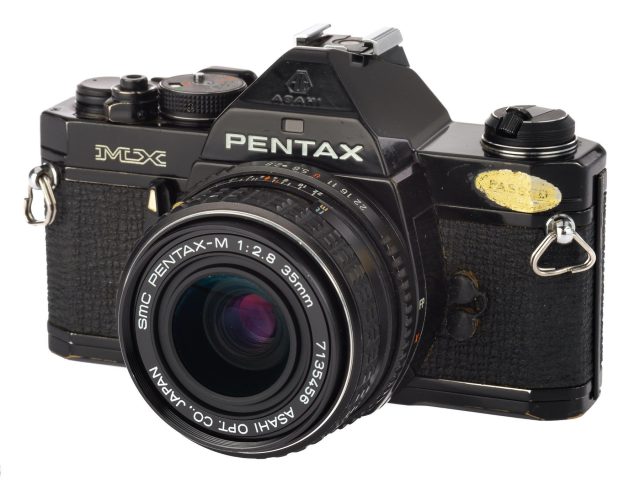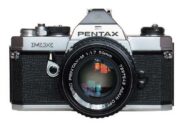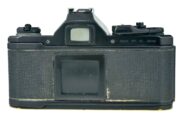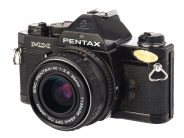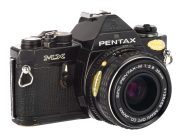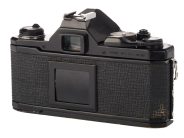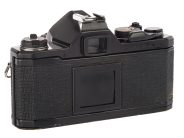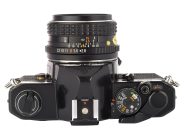Announced
Production status
System
Pentax K system cameras
- Asahi Pentax K1000
- Asahi Pentax K1000 SE
- Asahi Pentax K2
- Asahi Pentax K2 DMD
- Asahi Pentax KM
- Asahi Pentax KX
- Asahi Pentax ME
- Asahi Pentax MX
- Pentax *ist
- Pentax A3
- Pentax K-1
- Pentax K-1 Mark II
- Pentax LX
- Pentax ME F
- Pentax ME SE
- Pentax ME super
- Pentax MG
- Pentax MV
- Pentax MV1
- Pentax MZ-10
- Pentax MZ-3
- Pentax MZ-30
- Pentax MZ-5
- Pentax MZ-50
- Pentax MZ-5n
- Pentax MZ-6
- Pentax MZ-60
- Pentax MZ-7
- Pentax MZ-M
- Pentax MZ-S
- Pentax P30
- Pentax P30n
- Pentax P30t
- Pentax P50
- Pentax program A
- Pentax SF7
- Pentax SFX
- Pentax SFXn
- Pentax super A
- Pentax Z-1
- Pentax Z-10
- Pentax Z-1P
- Pentax Z-20
- Pentax Z-5
- Pentax Z-50
- Pentax Z-50P
- Pentax Z-5P
- Pentax Z-70
Asahi Pentax MX
35mm MF film SLR camera • Discontinued
Specification
| Format: | |
| 35mm full frame | |
Film type: | 135 cartridge-loaded film |
| Pentax K [45.5mm] | |
| Shutter: | |
Type: | Focal-plane |
Model: | Mechanical |
Speeds: | 1 - 1/1000 + B |
| Exposure: | |
Exposure metering: | Through-the-lens (TTL), open-aperture |
Exposure modes: | Manual |
| Physical characteristics: | |
Weight: | 495g |
Dimensions: | 135.8x82.5x49.3mm |
Manufacturer description #1
Introducing the new Pentax MX, the world's smallest, lightest, most compact, full-featured 35mm SLR with complete professional capabilities.
You're looking at the future. No other camera - regardless of size - has all the advanced features you'll find in the new Pentax MX.
Revolutionary new technology.
Our new light sensors represent a major advance in photo science. They're called Gallium Arsenide Phosphide Photo Diodes. GPDs for short. They give you a level of exposure accuracy and reliability never before attainable. GPDs react 1,000 times faster than conventional CdS cells at low light levels. There's no "memory lag."
The meter responds instantly and precisely to sudden changes in light. And, unlike silicon cells, GPDs are practically insensitive to infrared and temperature extremes. A special Temperature Compensation Circuit makes the metering system even more reliable.
Overall, our advanced new electronic circuitry uses only a fraction of the current needed by other cameras. That means extended battery life. Less frequent replacement. And many more exposures per set of batteries.
New full info viewfinder.
You'll see an image that's bigger and brighter than in most standard-size SLRs. You'll also see the aperture setting and the speed you've selected plus the two adjacent speeds. So you can concentrate on creating the picture. With our advanced LED technology, you just turn the settings until you see the green light inside the viewfinder. Click. Another perfect exposure. Want to control the exposure yourself? Easy. There are two amber LED signals: +1/2 stop and -1/2 stop. And two red LED signals: +1 stop and -1 stop or greater. You have total control.
New mirror system.
Our ingenious new air damping system minimizes mirror vibration. There is no need for mirror lock-up. Your pictures are always critically sharp. Even when you're doing exacting macro-photography or shooting at motor drive speeds.
New miniature lenses.
We have 11 of them. Ultra-compact. Lightweight. Super-multicoated (SMC Pentax M) lenses. And more are coming. With the full line of SMC Pentax bayonet mount lenses (all of which fit the new MX), you now have a choice of more than 40 lenses. From 15mm to 1000mm. Including superb macros and zooms.
New special screens. Our standard microprism/split-image screen will meet almost all your focusing requirements. But we have seven more for special applications. In seconds, you can change from one to another without the dust problems associated with removable prisms.
New accessory backs.
We have a bulk film back for 250 exposures. And a Dial Data back for imprinting each frame with the date, technical, identification or other information your picture assignments may require.
New Auto Winder and Motor Drive.
The Auto Winder MX is exceptionally small. Attached to the camera, the whole package is no bigger than a standard-size SLR. It enables you to shoot sequentially at nearly two frames per second. The Motor Drive MX is also extraordinarily compact. And shoots up to 5 fps. And, it works with either rechargeable NiCad battery pack, penlight batteries or AC current.
New human engineering.
The new MX is immediately comfortable in your hands. From its beveled edges to the placement of the controls, every part of the new MX is designed for fast, smooth, easy handling. Our advanced solid state electronics also makes it possible to pack more functions into less space. And, unlike some small camera bodies, we didn't use plastic to reduce weight. The MX body is all metal. And we made the mechanical parts stronger, too. The new MX is probably the most durable, most dependable camera you'll ever own.
Manufacturer description #2
Up against a challenge, you need a team you can count on. A team that's geared to work together, function smoothly and deliver results. That team's the MX system, from Pentax.
The sleek MX machine is human engineered to handle smoothly at any pace. Compact, perfectly balanced - and so lightweight it'll never slow you down.
MX advanced design and precision construction includes "most wanted" options as part of the standard equipment. GPD metering for fast, accurate response. Unaffected by normal temperature extremes or infrared rays, GPD's provide the consistency champions must deliver. "Magic Needles" make loading a snap.
One look through the brilliant panoramic viewfinder and you'll know you're handling something special. Silvered penta-prism shows a big, bright image. Full information viewfinder with LED shutter speed readout means you never have to remove the MX from your eye. Eight interchangeable focusing screens assure fast, sharp focusing for your exact photographic needs.
And precision MX can take it! Rugged, durable focal plane shutter and all metal body help keep MX out of the shop, right on track.
MX boasts a strong support system, too. Dozens of Super-Multi-Coated Pentax bayonet mount lenses, including the new ultra compact M-series miniatures, offer strong and easy-to-pack versatility. SMC lenses attach smoothly and instantly, bearing the high standards in craftsmanship that have made Pentax a leader in the optical industry. Screw-on filters for color correction and special effects give you extra mileage from your lenses. There's even special equipment like slide copiers, extension tubes and bellows.
If it's more speed you want, you've got it. Two ways. The MX motor drive shoots at up to 5 frames a second - while the lightweight MX auto winder advances at almost 2 frames per second.
Pentax MX system. Lightweight. Dependable. Versatile. And built to take whatever you can dish out.
Manufacturer description #3
TYPE: 35mm full-frame SLR camera with open-aperture center-weighted Through-The-Lens meter
LENS MOUNT: Pentax K bayonet
SHUTTER: Horizontal-run, rubberized silk focal-plane shutter; speeds from 1 to 1/1000 sec. plus B; shutter lock and "Cocked" indicator
FLASH SYNCHRONIZATION: FP and X sockets, plus hot/cold accessory shoe for X contact; 1/60 sec. X synchronization
SELF-TIMER: Delays shutter release to 4-12 seconds; self-timer starter button provided
VIEWFINDER: Silver-coated pentaprism finder; split-image microprism focusing screen (8 interchangeable screens); 95% of picture-taking area visible and 0.97x magnification (with 50mm lens at infinity); -0.5 diopter eyepiece. Information viewfinder shows f/stop, shutter speed and tri-colored LED read-out dots. Correction lens adaptor M, Magnifier M and Refconverter M fit the viewfinder frame
MIRROR AND DIAPHRAGM: Instant-return mirror and automatic diaphragm. Depth-of-field preview with self-timer lever
FILM WIND AND REWIND: Ratchet-type rapid wind lever, plastic-tipped for winding comfort. 162° throw with a stand-off angle of 20°. Rewind crank for speedy film rewind
FILM LOADING: New magic-needle quick/sure loading
AUTOMATIC WINDER: MX camera body accepts Winder MX for up to 2 frames-per-second (single-frame and consecutive exposure operation possible) and Motor Drive MX for up to 5 frames per second (single-frame and consecutive exposure operation possible), for automatic, speedy film wind and shutter cocking
EXPOSURE COUNTER: Automatic reset type
EXPOSURE METER: Open-aperture, center-weighted Through-The-Lens meter, with GPD cells for fast light response, with tri-colored LED exposure read-out; rapid wind lever and shutter release button acting as meter switch. Exposure range: EV 1-19 (ASA 100, f/1.4). Film speed range: ASA 25-1600
POWER SOURCE: Two 1.5V Alkaline (LR44) or Silver-oxide (G13) batteries; LEDs double as battery check lamp
BACK COVER: Standard back with memo holder, interchangeable with Magazine Back MX, Dial Data MX for data recording on film
Manufacturer description #4
The new Pentax MX is the smallest and lightest professional motor drive 35mm SLR available.
Plus, it has the most advanced features of any 35mm SLR...
- GPD metering for instant accurate response
- Full information viewfinder
- Tri Color LED exposure readout
- Interchangeable focusing screens
- MX Winder (2 fps) or MX Motor Drive (5 fps)
The MX is backed by the full line of Pentax accessories and over 40 Super-Multi-Coated Pentax lenses, including the new compact M Series lenses.
Manufacturer description #5
The announcement of another high quality camera from Asahi Optical Company can hardly come as a surprise. After all, Asahi Optical has been manufacturing incomparable cameras for the past 25 years. With 6,000,000 Asahi Pentaxes already sold, there isn't anyone who hasn't heard of a Pentax camera. So why all the fuss about another one?
Well, a revolution is always exciting. Take the time Asahi Optical introduced the world's first through-the-lens metering system, there was a lot of excitement created then, and you have to admin the excitement was justified. The same is true for the time Asahi unveiled the first quick-return mirror, or the first aperture-priority automatic exposure 35mm single lens reflex. What specifically, then, is so exciting about the very latest Asahi Pentax, the MX? The big fuss is doubtlessly due to the fact that never before have so many revolutionary features been simultaneously incorporated into a single camera.
- World's smallest 35mm SLR motor drive camera.
- World's lightest 35mm SLR motor drive camera.
- Absence of mirror shock.
- World's first camera with Gallium Arsenide Phosphide Photo Diodes.
- World's first professional ultra compact camera with full-information viewfinder.
- World's first "magic needle" loading system.
- 8 interchangeable focusing screens.
- Choice of Auto Winder (2 fps) or Motor Drive (5 fps).
- Accepts interchangeable data back.
- 250 exposure Bulk Film Back available.
- Extensive range of SMC Pentax lenses to choose from.
- Smaller camera, but bigger, brighter viewfinder.
- Smaller camera, but bigger, stronger parts.
- Tri-color LED exposure read-out.
- Center-weighted exposure measurement.
- Three-way focusing.
- Hot shoe with built-in circuit breaker.
- Memo holder.
- Self-timer.
- FP and X synchronization.
- Depth of field preview.
- Unique meter switch.
- Shutter release button lock.
- Shutter cocked indicator.
- Extensive ASA range of 25-1600.
- ASA dial safety lock.
- Broad exposure measurement range of EV 1-19 (ASA 100, f/1.4).
Special editions (1)
- Asahi Pentax MX "20th Anniversary Japan Camera Show" (20 units) - 1979
Similar cameras (66)
35mm full frame • Manual focus • Film • Singe-lens reflex • Pentax K mount
| Model | Shutter | Metering | Modes | Year |
|---|---|---|---|---|
| Almaz-103 aka Алмаз-103 |
M, 1/1000 | -- | M | 1980 ● |
| Alpa Si 3000 | E, 1/1000 | TTL • OA | AM | ● |
| Chinon CA-4 aka Agfa Selectronic 2 |
E, 1/1000 | TTL • OA | A | 1980 ● |
| Chinon CA-4s | E, 1/1000 | TTL • OA | A | ● |
| Chinon CE-4 aka Agfa Selectronic 3 |
E, 1/1000 | TTL • OA | AM | 1979 ● |
| Chinon CE-4s | E, 1/2000 | TTL • OA | AM | 1982 ● |
| Chinon CE-5 | E, 1/2000 | TTL • OA | AM | 1982 ● |
| Chinon CG-5 | E, 1/1000 | TTL • OA | AM | 1982 ● |
| Chinon CM-4 aka Agfa Selectronic 1 |
M, 1/1000 | TTL • OA | M | 1980 ● |
| Chinon CM-4s aka Vivitar XV-11 |
M, 1/1000 | TTL • OA | M | ● |
| Chinon CM-5 aka Vivitar XV-5 |
M, 1/1000 | TTL • OA | M | 1982 ● |
| Chinon CM-7 | M, 1/2000 | TTL • OA | M | 1987 ● |
| Chinon CP-5 Twin Program | E, 1/1000 | TTL • OA | PAM | 1983 ● |
| Chinon CP-5s Twin Program | E, 1/1000 | TTL • OA | PAM | 1984 ● |
| Chinon CP-6 Spot Twin Program | E, 1/1000 | TTL • OA | PAM | 1985 ● |
| Chinon CP-7m Multi-Program | E, 1/2000 | TTL • OA | PAM | 1986 ● |
| Chinon CP-X Program | E, 1/1000 | TTL • OA | PAM | 1985 ● |
| Chinon DP-5 Double Program | E, 1/1000 | TTL • OA | PAM | ● |
| Chinon DSL | M, 1/1000 | TTL • OA | M | ● |
| Cimko LS-1 aka Lindenblatt KL-2 |
E, 1/1000 | TTL • OA | AM | 1982 ● |
| Cosina C1 aka Phoenix P1 aka Voigtlander VSL 40 |
M, 1/2000 | TTL • OA | M | ● |
| Cosina C1s | M, 1/2000 | TTL • OA | M | ● |
| Cosina C2 | E, 1/1000 | TTL • OA | AM | ● |
| Cosina CS-1 | E, 1/1000 | TTL • OA | M | 1978 ● |
| Cosina CS-2 | E, 1/1000 | TTL • OA | A | 1978 ● |
| Cosina CS-3 | E, 1/1000 | TTL • OA | AM | 1978 ● |
| Cosina CT-1 aka Vivitar XV-1 aka Vivitar XV-10 |
M, 1/1000 | TTL • OA | M | 1979 ● |
| Cosina CT-10 | E, 1/1000 | TTL • OA | A | 1981 ● |
| Cosina CT-1A aka Soligor SC-1 |
M, 1/1000 | TTL • OA | M | 1980 ● |
| Cosina CT-2 aka Vivitar XV-20 |
E, 1/1000 | TTL • OA | A | 1980 ● |
| Cosina CT-20 | E, 1/1000 | TTL • OA | A | 1981 ● |
| Cosina CT-3 | E, 1/1000 | TTL • OA | A | 1981 ● |
| Cosina CT-4 aka Vivitar XV-3 |
E, 1/1000 | TTL • OA | AM | 1981 ● |
| Cosina CT1 Super aka Exakta HS-2 |
M, 1/2000 | TTL • OA | M | 1984 ● |
| Cosina CT1EX aka Exakta HS-10 aka Vivitar V335 |
M, 1/2000 | TTL • OA | M | 1988 ● |
| Cosina CT1G aka Exakta HS-1 |
M, 1/1000 | TTL • OA | M | 1984 ● |
| Cosina CT9 aka Exakta HS-40 |
E, 1/1000 | TTL • OA | AM | 1986 ● |
| Cosina E1 Solar | M, 1/2000 | TTL • OA | M | 1994 ● |
| Cosina PM-1 | M, 1/1000 | TTL • OA | M | ● |
| Cosina [Computer] CT7 aka Exakta HS-3 |
E, 1/1000 | TTL • OA | AM | 1981 ● |
| Ricoh KR-10 aka Ricoh CR-10 aka Ricoh XR-1000S |
E, 1/1000 | TTL • OA | AM | 1980 ● |
| Ricoh KR-10SE | E, 1/1000 | TTL • OA | AM | 1980 ● |
| Ricoh KR-5SV | M, 1/2000 | TTL • OA | M | 2000 ● |
| Ricoh XR Solar | M, 1/2000 | TTL • OA | M | 1994 ● |
| Ricoh XR-1 | M, 1/1000 | TTL • OA | M | 1977 ● |
| Ricoh XR-1S | M, 1/1000 | TTL • OA | M | 1979 ● |
| Ricoh XR-2 | E, 1/1000 | TTL • OA | AM | 1977 ● |
| Ricoh XR-2000 aka Ricoh KR-10 Super |
E, 1/1000 | TTL • OA | AM | 1982 ● |
| Ricoh XR-2S | E, 1/1000 | TTL • OA | AM | 1979 ● |
| Ricoh XR-8 aka Ricoh KR-5 Super II |
M, 1/2000 | TTL • OA | M | 1993 ● |
| Ricoh XR-8 Super aka Ricoh KR-5 III |
M, 1/2000 | TTL • OA | M | 1994 ● |
| Ricoh XR-F | E, 1/1000 | TTL • OA | AM | 1983 ● |
| Ricoh XR-S | E, 1/1000 | TTL • OA | AM | 1981 ● |
| Ricoh XR5 aka Ricoh CR-5 aka Ricoh KR-5 Super |
M, 1/1000 | TTL • OA | M | 1980 ● |
| Ricoh XR500 aka Ricoh KR-5 |
M, 1/500 | TTL • OA | M | 1978 ● |
| Ricoh XR500 auto | E, 1/1000 | TTL • OA | AM | 1982 ● |
| Ricoh XR6 | E, 1/1000 | TTL • OA | AM | 1981 ● |
| Ricoh XR7 | E, 1/1000 | TTL • OA | AM | 1982 ● |
| Topcon RM 300 aka Edixa CX 5 aka Exakta KE 4 aka Exakta KE 5 |
M, 1/1000 | TTL • OA | M | 1978 ● |
| Zenit-122K aka Зенит-122К |
M, 1/500 | TTL • WA | M | 1990 ● |
| Zenit-14 aka Зенит-14 |
E, 1/1000 | TTL • OA | M | 1987 ● |
| Zenit-212k | M, 1/500 | TTL • WA | M | 1995 ● |
| Zenit-AM / AM2 / AM3 aka Зенит-АМ / АМ2 / АМ3 |
E, 1/1000 | TTL • OA | A | 1989 ● |
| Zenit-APK aka Зенит-АПК |
E, 1/2000 | TTL • OA | AM | 1992 ● |
| Zenit-Avtomat aka Зенит-Автомат |
E, 1/1000 | TTL • OA | A | 1985 ● |
| Zenit-km | E, 1/2000 | TTL • OA | AM | 2001 ● |
